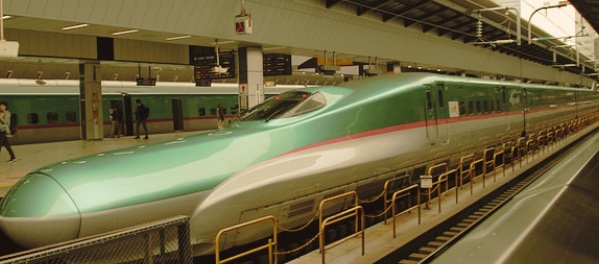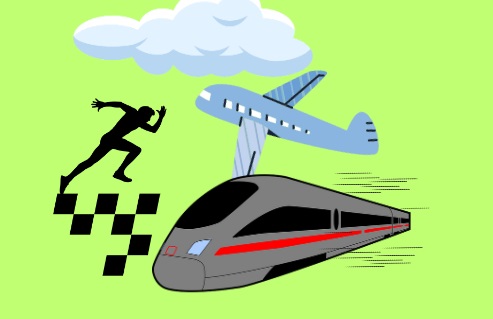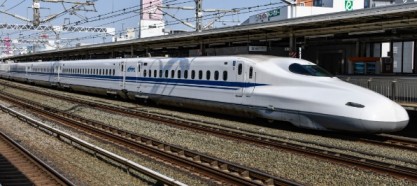The bullet train is getting popularity day by day because of the bullet train’s speed. By enabling quick and effective transportation between cities, the technology behind bullet trains has transformed train travel all over the world. Advanced motors and magnetic levitation are used in conjunction with the technology of these trains to move smoothly over the tracks.

The Birth of Bullet Trains:
The introduction of bullet trains was pioneered in Japan. This innovative mode of transportation was introduced with the premiere of the legendary Shinkansen in 1964. Bullet trains offered a faster and more effective option for intercity travel because they were designed to serve a country with a dense population and little room for building airports and highways.
What is a bullet train?
A bullet train is a special kind of train designed for swift, effective transit at very high speeds. These trains are substantially faster than conventional trains because of cutting-edge technology and features. The aerodynamic and streamlined shapes of bullet trains reduce air resistance, allowing for swift and effective movement. To move the train ahead steadily and precisely, they use strong electric or magnetic propulsion technologies, such as linear induction motors or maglev technology. In order to ensure a safe and dependable operation, bullet trains run on specially designed tracks. By accelerating economic growth, lowering travel times between major cities, and providing a more environmentally friendly means of transportation, these trains have revolutionized rail travel.
How fast is a bullet train speed?
The astounding speeds of bullet trains, sometimes known as high-speed trains, are well known. A bullet train’s exact speed can vary depending on its model and the infrastructure it uses. It may move at an average speed of 186 to 217 miles per hour or 300 to 350 kilometers per hour. On the other hand, certain more contemporary train models have occasionally exceeded 431 km/h (268 mph), going even faster.
Details about high-speed bullet train:
The Shanghai Maglev Train in China is, in my opinion, the world’s fastest commercial bullet train. The maximum speed that the Shanghai Maglev can go is 431 km/h (268 mph). It links Shanghai’s central business district with Pudong International Airport using the Shanghai Maglev Line. Thanks to electromagnetic forces, this magnetic levitation (maglev) train hovers and travels at incredibly rapid rates of speed.
This train covers the 30 km (18.6 mi) route at top speed in 7 minutes and 20 seconds. Some trains take an extra 50 seconds in the early morning and late afternoon. And 186 mph or 300 km/h may be reached by railway in 2 minutes and 15 seconds. After 4 minutes, the maximum normal operating speed of 431 km/h (268 mph) is reached.
Which countries are using high-speed bullet train?
Many nations nowadays around the world operate bullet trains. Japan, China, France, Germany, Spain, Italy, South Korea, and Taiwan are already successfully operating bullet trains. The very first and still most recognizable bullet train system was Japan’s Shinkansen, which is renowned for its punctuality and effectiveness. China operates the world’s fastest commercial bullet train and has established a significant high-speed rail network. The TGV in France, ICE in Germany, and AVE in Spain are well-known high-speed rail networks in Europe.
Why is the speed of the bullet train so fast?
Due to a number of elements, bullet trains are able to travel at astounding speeds. First, their aerodynamic and streamlined shapes reduce air resistance, enabling smoother motion at high speeds. Second, large thrust and acceleration are produced by strong electric or magnetic propulsion technologies, such as linear induction motors or maglev technology. Third, the tracks on which bullet trains run were created specifically to support high-speed travel, with soft curves and sophisticated signaling systems ensuring safe operations. Furthermore, rigorous safety controls, such as redundant control systems and thorough monitoring, allow for effective operations at high speeds. Bullet trains are able to reach incredible speeds thanks to the convergence of these technical breakthroughs and infrastructure concerns, greatly lowering travel times and offering quick and effective transit solutions.

Is a bullet train faster than Airplane?
Bullet trains and airplanes have various uses and advantages when it comes to speed. Airplanes are generally faster for long-distance travel. Because bullet trains usually run at 300 to 400 kilometers per hour (186 to 248 miles per hour). In order to travel farther in less time, airplanes can fly at significantly faster speeds—often topping 900 kilometers per hour or more. As they do not require additional time-consuming procedures like check-in, security checks, or boarding, bullet trains can be more cost-effective for shorter lengths, usually up to 500 kilometers. The precise routes, distances, and general conditions of the trip will ultimately determine which mode of transportation is faster: bullet trains or airplanes.
Advantages & Disadvantages:
Advantages:
One key benefit is the markedly decreased travel time between cities, which transforms it into a practical and effective way of transportation. While traveling, bullet trains offer a quiet, comfortable ride with little vibration. This is considered to be safer than other forms of transportation because of its advanced safety measures and stringent operating procedures. In addition, they generate fewer emissions per passenger than airplanes do. Bullet trains generally contribute to environmentally favorable transportation solutions.
Disadvantages:
The cost of constructing and maintaining the essential infrastructure for bullet train systems is by far the biggest drawback. It can be expensive and time-consuming to construct customized lines and stations. Due to the limited number of bullet train routes, some areas could also be challenging to reach. Because of the high speed of bullet trains, straighter routes would also be necessary. Which could necessitate more substantial land acquisition and harm already-existing towns or landscapes. High-speed bullet train rates are more expensive than other forms of transportation.
The incredible speeds of bullet trains have changed the transportation industry. The introduction of these fast trains, known as Shinkansen in Japan, transformed how people commute between cities. Using high speeds, bullet trains significantly reduce travel times. They have established new benchmarks for comfort, safety, and speed, giving passengers a quick and delightful ride. The future of bullet train speed appears positive, offering even quicker. And more effective ways of transportation as nations around the world continue to invest in high-speed rail infrastructure.
